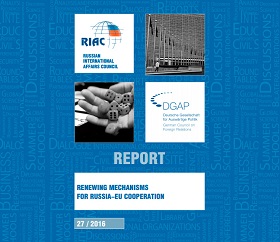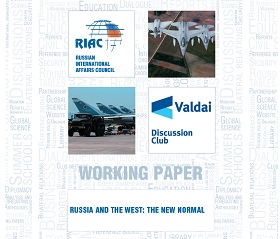Just six months ago, predictions of imminent revolution in world politics were all the rage in Russia and beyond. Observers saw plenty of signs of impending cataclysms: the UK’s decision to leave the European Union, the victory of a political outsider in the U.S. presidential election, the rise of far-right populism and anti-globalism in the West, and the wave of migration threatening to engulf Europe.
It seemed as if it wouldn’t take much for the entire current system of world politics to come tumbling down like a house of cards. The future of the EU was the subject of the largest number of bleak forecasts. With the so-called “European project” apparently doomed, Russia’s troubles looked a lot less dramatic in comparison.
The expectation (and for some, eager anticipation) of the inevitable demise of the existing world order could not but affect Russia’s foreign policy. What’s the point of investing effort and political capital in negotiations with leaders whose days are numbered? Isn’t it better to take a wait-and-see approach, watching the epic decline of the old era from the sidelines?
Despite all of its problems, Russia seemed to have one undeniable advantage over the EU: time. Russia’s ailments are chronic and frequently latent, ripening for many years, if not decades. Europe’s concerns, in the meanwhile, escalated from chronic to acute last year.
The events of 2017, however, suggest that the end of the old era is at minimum being postponed—at least in Europe. Euroskeptic populists lost elections in the Netherlands and France, and their prospects at the upcoming elections in Germany look poor. Brexit has actually boosted the popularity of the European idea: none of the remaining 27 EU members are likely to follow Britain out of the union. The migration crisis has not been solved completely, but it appears less frightening than it did in 2015.
If there is an escalation in the West, then it is on the other side of the Atlantic. It seems that the United States is entering its deepest political crisis since Watergate, accompanied by a social crisis that extends far beyond Washington. Hopes that Donald Trump would be a strong president who could heal the divide in America have not materialized, and the polarization of political and social groups is only growing. Accordingly, the White House is losing its ability to conduct any sort of consistent foreign policy, not to mention pursue any long-term strategy.
The EU is beginning to respond to its systemic ailments, while problems are only growing in the United States. These seemingly incongruous processes both show that on the whole, the postmodern world is better able to stand up to change and resist destabilization than some might have expected six months ago.
What does this mean for Russia? Above all, we shouldn’t entertain the illusion that tensions with the West will somehow be resolved as a result of radical changes there, and that Moscow’s biggest task is to “wait out” a temporary period of unfavorable world order. The Kremlin no longer has the advantage of time.
In the foreseeable future, Russia can at best hope for tactical cooperation with the United States on a limited number of issues: Syria, North Korea, the Arctic, and nuclear nonproliferation. If Russia is lucky, strategic stability, the fight against international terrorism, and a few other issues could be added to the list. However, there can be no talk of establishing a new global order in cooperation with the United States. The anti-Russia consensus in Washington is unwavering.
Europe, on the other hand, offers Russia more opportunities. The EU will have to reconsider many of its long-standing mechanisms, procedures, and priorities if it wants to overcome its numerous problems. Russia could facilitate EU transformation in a direction favorable to Russia’s own interests, provided that it achieves at least some progress on Ukraine, an issue that is critical for Russia-EU relations.
If there is to be no revolution in world politics in 2017, then we must seek practical solutions within the existing system of political coordinates. One mutually acceptable model for relations between Russia and the EU is the so-called “hybrid relations” model.
Hybrid vehicles use two or more sources of energy, usually a conventional internal combustion engine (ICE) and an electric battery. In our case, the old model of geopolitical confrontation between East and West (the Cold War model) plays the role of an ICE. This model is expensive and outdated, but did provide sufficient stability and predictability, both in Europe and around the world.
It offered numerous channels for political cooperation, military contacts, risk reduction measures, and arms control agreements. The Cold War model also presumed a certain level of mutual respect and even trust. Why not return to the time-tested practice of managing the confrontation using existing mechanisms such as the NATO-Russia Council, the OSCE, and the Council of Europe, or new ad hoc formats such as the frequently proposed NATO-Russia Military Crisis Management Group?
In certain spheres, there was never even a departure from this model of relations—U.S.-Russian cooperation in the nuclear sector, for example. For all of their positive significance, the two remaining pillars of nuclear cooperation—the Intermediate-Range Nuclear Forces Treaty and New START—are fully in line with the logic of controlled confrontation and the Cold War paradigm.
However, repairing and restarting the old ICE is a necessary but not sufficient condition for stabilizing relations between Russia and the West. This engine has at least four intrinsic limitations.
First of all, the Cold War model is inherently static. It is aimed at maintaining the status quo and lacks the capacity for evolution and reform.
Second, the Cold War model was based on the existence of two vertically organized military-political blocs that divided Europe into the Soviet and U.S. spheres of influence. Today, it would be impossible to split Europe in this manner: the very idea of “spheres of influence” is considered obsolete and unacceptable, at least in the West. And Russia today isn’t the same as the Soviet Union was at the peak of its power. Geopolitical parity between East and West would only be possible with the establishment of a Russian-Chinese military-political alliance.
Third, the Cold War model was fashioned by Soviet and U.S. leaders to stand up to the biggest threats of the twentieth century. The twenty-first century has brought many new challenges, and the Cold War model can offer little help in fighting the new generation of international security risks.
Fourth, the Cold War model was relatively effective when the two opposing systems were almost completely isolated from each other and divided by incompatible ideologies. Today, there is no longer such isolation between Russia and the West, and it cannot be recreated, despite efforts on both sides.
All of these limitations of the old ICE dictate the need for it to be supplemented with a new electric motor. The system of global, regional, and sub-regional regimes that preserve and expand “common spaces” for Russia and Europe, or for Eurasia and the Euro-Atlantic, could serve as such a new motor.
At first, it would probably be easier to maintain and develop these regimes in less politically sensitive spheres, such as education, science, and culture. However, the model could also be extended to unconventional security risks such as international terrorism, drug trafficking, cross-border crime, energy security, and cybersecurity.
Whereas the Cold War model is inherently rigid, requiring clear codification of agreements, the regimes model is flexible, making it possible to bypass protracted coordination of technical details and avoid lengthy, complex ratification procedures. And while the Cold War model depends on the existence of a universally recognized hierarchy among participants of international relations, the regimes model is based on horizontal cooperation by interested parties, which can include non-state players such as regions, municipalities, private companies, civic institutions, international organizations, and transborder movements. This greatly increases the number of potential stakeholders interested in the development of cooperation, and creates a critical mass for a subsequent breakthrough.
So how can two such different models of relations between Russia and the West be unified in a single hybrid format? In view of the extensive social, professional, and cultural fragmentation of modern society, and of the existence of many group and individual identities, each model will find its target audience, supporters, and agents, both in Russia and in the West.
The two proposed models will be interconnected vessels that cannot be isolated from each other. The art of diplomacy requires, above all, ability to play chess on several boards at once—or even three completely different games. The key is to separate the spheres where the Cold War model and the regimes model are applied, gradually shifting the balance from the former to the latter.
It will take a long time before electric motors fully replace ICEs, but hybrid vehicles are an important step in that direction. Working on perfecting hybrid relations between Russia and the West appears to be a more logical and promising approach than hoping for the expeditious arrival of a post-Western world. One hundred years ago, the Bolsheviks were waiting for a world proletarian revolution to occur any day. Where are those Bolsheviks today?
First published in Carnegie Moscow Center.









